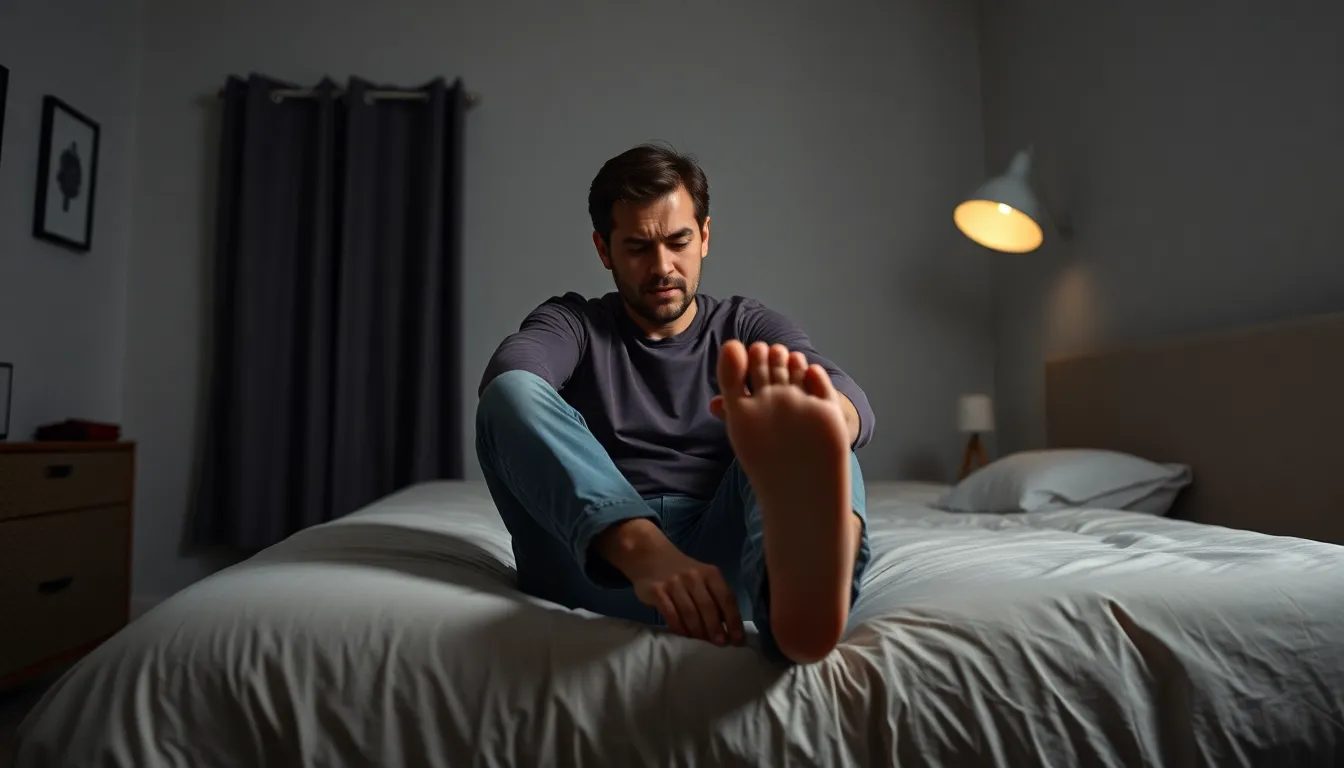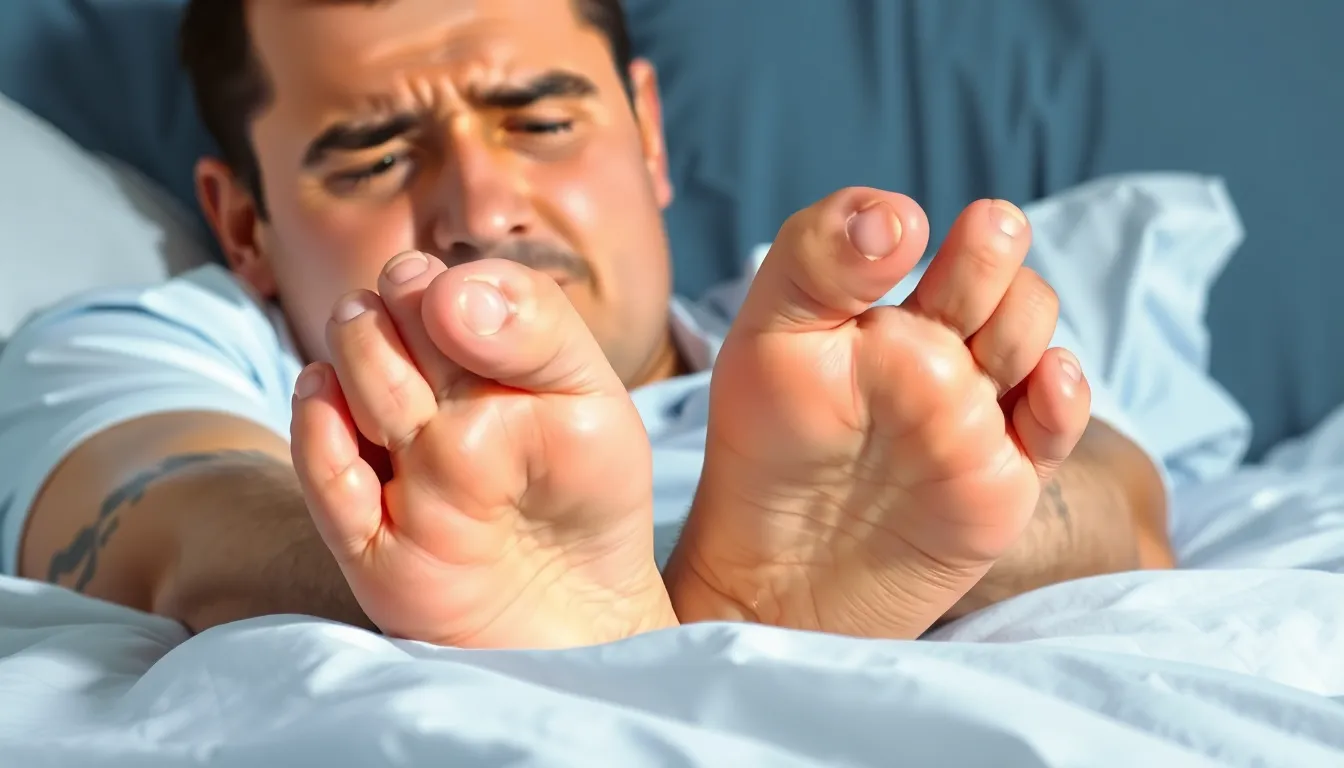Picture this: it’s a peaceful night, you’re cozied up in bed, and suddenly your toes decide to throw a wild party of cramping and curling. If you’ve ever experienced this midnight toe tango, you’re not alone. Many people find themselves in a battle with their own feet, wondering why their digits are staging a rebellion when all they want is a good night’s sleep.
Table of Contents
ToggleUnderstanding Toes Cramping and Curling at Night
Nighttime toe cramps can lead to discomfort that disrupts sleep. Recognizing symptoms and causes can help manage this issue effectively.
Common Symptoms
Typical symptoms include sudden pain and a tight sensation in the toes. These cramps may cause toes to curl involuntarily. Cramping often occurs during sleep, making it difficult to find a comfortable position. Duration can vary but usually lasts from several seconds to a few minutes. Many individuals report feeling soreness in the affected area afterward.
Potential Causes
Several factors can contribute to nighttime toe cramps. Dehydration plays a significant role, as inadequate fluid intake can lead to muscle cramps. Nutritional deficiencies, particularly in magnesium, potassium, and calcium, might also be responsible. Prolonged inactivity or poor circulation in the legs may increase susceptibility to cramps. Additionally, certain medications, like diuretics and statins, may heighten the risk.
Risk Factors

Various factors contribute to nighttime toe cramps. Understanding these risks can help in managing and preventing the discomfort.
Lifestyle Factors
Dehydration often plays a significant role in muscle cramps. Inadequate hydration lowers electrolyte levels, leading to increased cramping. Additionally, prolonged periods of inactivity can weaken muscle strength and flexibility. Sitting or standing for extended times may leave muscles more prone to spasms. Wearing tight footwear restricts blood flow, creating a higher risk of cramps during sleep. Regular physical activity enhances muscle health, reducing the likelihood of nighttime issues.
Medical Conditions
Certain medical conditions elevate the risk of toe cramps. Peripheral artery disease affects blood circulation, contributing to cramps. Diabetes may lead to nerve damage, increasing susceptibility to cramping sensations. Thyroid problems disrupt metabolism, which can influence muscle function. Moreover, neurological conditions like Parkinson’s disease can affect muscle control and lead to spasms. Medications prescribed for these conditions can increase cramping occurrences as well.
Home Remedies and Treatments
Finding effective remedies for nighttime toe cramps can significantly enhance comfort during sleep. Multiple strategies exist for alleviating discomfort and preventing future occurrences.
Stretching Exercises
Stretching exercises effectively reduce the frequency of toe cramps. Implementing calf stretches enhances flexibility in lower legs. Another useful stretch involves pointing and flexing the toes several times to promote circulation. Incorporating these stretches into the evening routine may lead to fewer incidents of cramping. Engaging in gentle yoga poses also strengthens the muscles in the feet and improves overall foot health.
Hydration and Nutrition
Proper hydration plays a crucial role in preventing toe cramps. Drinking sufficient water throughout the day ensures muscles stay hydrated and function properly. Additionally, incorporating foods rich in magnesium, potassium, and calcium can further decrease cramping risk. Bananas, leafy greens, and yogurt are excellent sources of these nutrients. Maintaining a balanced diet with adequate vitamins and minerals promotes overall muscle health and reduces the likelihood of cramps during the night.
When to Seek Medical Attention
Identifying when to seek medical attention for nighttime toe cramps is crucial. Persistent or severe symptoms may indicate underlying health issues.
Signs of Serious Conditions
Should toe cramps occur frequently, take note of specific warning signs. Experiencing swelling, redness, or warmth in the affected area raises concern. If cramps accompany persistent pain or numbness, it signals potential nerve damage. Symptoms like weakness in the legs or feet may suggest circulatory problems. Individuals with diabetes should pay attention if cramps occur alongside blood sugar fluctuations. Identifying these signs early can lead to appropriate medical evaluation.
Recommended Specialist Consultations
Consult a healthcare professional if cramps become a regular occurrence. A doctor can perform tests to determine potential causes, including blood tests for nutritional deficiencies. It might be beneficial to see a neurologist if nerve damage is suspected. In cases of circulatory issues, a vascular specialist could provide targeted advice. Always consider discussing medication effects with a pharmacist or prescribing physician, as certain drugs could contribute to cramping. Seeking timely consultations ensures the right course of action.
Conclusion
Nighttime toe cramps can be a frustrating experience that disrupts sleep and affects overall well-being. By understanding the causes and risk factors associated with these cramps, individuals can take proactive steps to reduce their occurrence. Implementing simple lifestyle changes such as staying hydrated, stretching regularly, and maintaining a balanced diet can make a significant difference.
For those who find their symptoms persist or worsen, seeking medical advice is crucial. Timely consultations with healthcare professionals can help identify underlying issues and provide tailored solutions. With the right approach, it’s possible to enjoy more restful nights and improved foot health.







